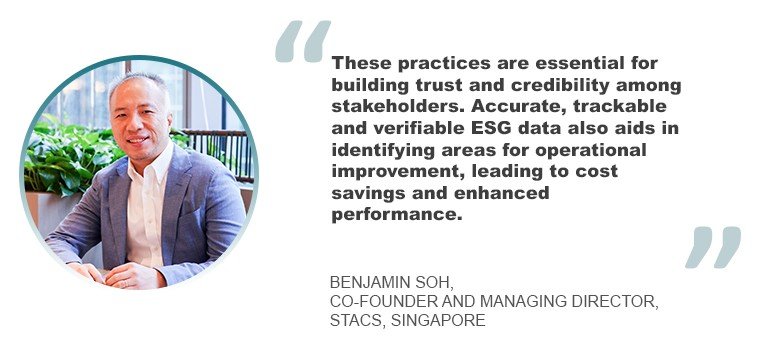“Parties that contravene the relevant sections under the aforementioned ordinances and codes of practices may be liable to imprisonment for the most serious offences and may be subject to sanctions such as fines, injunctions, revocation or suspension of licenses, regulatory review and investigation,” he said. “There could also be civil claims in respect of false or misleading statements.”
Similar to Hong Kong, there are no specific laws in China regulating environmental advertising claims and greenwashing. However, advertisements containing environmental claims may be subject to the broader regulatory framework established by key laws, such as the People’s Republic of China (PRC) Advertising Law, the PRC Anti-Unfair Competition Law, the PRC Product Quality Law and the PRC Environmental Protection Law.
“Depending on the severity of the violation, repercussions may include forced cessation of the advertisements, actions to eliminate the adverse effects of the advertisement (i.e. publication of legal announcements in approved newspapers or journals), substantial fines of up to 10 times the original advertising expense or Rmb2 million (US$275,500), where the amount of the advertising expense is difficult to be determined or obviously low, and revocation of the company’s business license. The specific penalties imposed will depend on the nature and extent of the greenwashing practice, but companies found in violation of such may face a range of punitive legal and financial consequences,” he said.
He added: “To mitigate these risks, companies in Hong Kong and China should ensure that any environmental claims they make are substantiated, specific and where applicable aligned with recognized standards and certifications. They should also implement robust internal auditing and disclosure processes to verify the accuracy of their environmental data and claims before communicating them publicly. Any communication should not be misleading.”
Using green marketing and green trademarks
Green marketing has been adopted by businesses and companies in a bid to keep up with the demand from consumers for climate-ethical goods and services. In an article published in December 2022 titled “Green trademarks and the risk of greenwashing,” WIPO Magazine explained what green marketing encompassed. This included “adopting brand names that suggest green; using words like sustainable, compostable, green, organic, eco, zero impact and natural; featuring glossy shots of beautiful mountains, oceans and forests as backdrops in their advertising; use of green-based colour schemes for advertising fonts and text; and making claims about the environmental benefits their products confer.”
According to Louis, in Singapore, the number of trademark applications that include terms that suggest environmental sustainability like “sustainable,” “green,” “organic” and “climate” has increased. In the last 10 years (June 1, 2014, to May 31, 2024), the following numbers of trademark applications with specific terms were observed: 78 for “sustainable,” 789 for “green”, 225 for “organic” and 82 for “climate.” In comparison, in the 10 years prior (June 1, 2004, to May 31, 2014), the following numbers of trademark applications with specific terms were observed: 21 for “sustainable,” 692 for “green”, 193 for “organic” and 16 for “climate.”
In both time periods referenced above, the term “green” included marks not specifically in reference to environmental friendliness, although a cursory look reveals that many of them are in reference to the environment.
“It is difficult to say whether these ordinary trademarks can be effectively utilized to substantiate environmental claims,” said Louis. “While the Intellectual Property Office of Singapore (IPOS) can issue absolute ground objections and/or third parties may oppose the registration of these marks on the basis that the mark is of such a nature to deceive the public or made in bad faith, objections or oppositions grounded on such bases rarely happens, if at all. Simply put, IPOS is not the proper governing body to adjudicate environmental claims. Consumers have to recognize and be educated that these are the businesses’ and companies’ choice of mark. They are not to be taken as a badge of certification that the products and/or services to which such marks are applied are actually ‘green.’ The onus remains on consumers to conduct their research, review the brands’ websites and substantiation claims before making a purchasing decision.”
Khosa added: “It may not be within an average consumer’s knowledge to appreciate the difference between an ordinary trademark and a certification mark. There are ordinary trademarks on the IPOS trademarks database that may come across to consumers as being a badge of certification that certifies that the goods and/or services to which it is applied are eco-friendly. In relying on such marks as badges of certification, consumers may be under the impression that they have altered their purchasing behaviour by being on the lookout for such marks, unaware that these are the companies’ or businesses’ own badges of origin.”
Certification marks, on the other hand, are regulated according to the regulations set by the owner of the certification mark. For instance, the Singapore Environmental Council (SEC) in Singapore is the owner of the Eco Manufacturing certification mark. Organizations in Singapore may apply to the SEC for certification; upon approval, they can use and display this certification mark, indicating to consumers that they have met the SEC’s criteria.
“While these certification marks are imbued with a higher level of credibility than ordinary trademarks, it will largely depend on those certified under such marks, as well as the owner of such certification marks, to ensure strict compliance with the regulations pursuant to which use of the certification mark is permitted,” said Khosa. “The owners of the certification mark usually, in its regulations, indicate a certification fee. These owners thus bear the onus to continuously monitor and regulate compliance with said regulations so as to maintain the credibility of the certification mark.”
Chatterton added that with growing demand and expectations for green products, businesses are increasingly interested in using green trademarks as part of their marketing strategy to showcase their environmental commitment. Green trademarks generally refer to trademarks that incorporate messages or descriptions related to environmental or sustainability impacts or credentials. For example, a green trademark may incorporate green terms such as “green,” “eco” and “sustainable,” as well as other environmental imagery such as an earth symbol.
“Since green trademarks may consist solely of generic or descriptive terms and relevant green terms may not be substantiated, any application for a green trademark in Hong Kong or China may run the risk of being refused on the grounds that it lacks distinctive character, is descriptive of the designated goods or services and/or is likely to deceive the public,” he said.
He continued: “That said, the trademark laws of both China and Hong Kong provide for the registration of certification marks and collective marks. Certification marks indicate that the goods or services have been tested, examined or certified in some way by an independent organization not involved in the trade of those goods or providing the services, in accordance with methods determined by the owner of the certification mark to indicate or guarantee certain specific characteristics or quality. Collective marks indicate the commercial origin of goods or services from members of an association. The appropriate use of a certification mark or collective mark could be an effective option for companies to demonstrate their compliance with the relevant regional and international sustainability standards.”
He said that to be truly effective, the use of any green trademark, certification or collective mark should be part of a broader corporate strategy that includes adherence to relevant regulations (including advertising laws and consumer protection laws), comprehensive supply chain transparency, ongoing monitoring and verification, and clear, honest communication to educate and empower consumers.
Best practices for brands and businesses
Cleary said that for trademarks that include environmental claims, it’s important that those claims are substantiated. “Otherwise, the trademark can be rejected as being contrary to the Trade Marks Act 2002,” he said. “Also, pure environmental claims might be perceived to be descriptive and therefore lack a distinctive character or be seen to consist only of indications designating the characteristics of the goods or services, and so not be registerable.”
He continued: “So unless there is something very distinctive in the trademark, word marks alone will generally struggle to be registerable. To avoid any issue, we would always recommend incorporating either graphics and making the mark a logo mark or a combination mark (words and logo). That is particularly the case with certification marks, where companies will want to show easily in visual terms that they have the certification rather than explain it. In that case, a logo or combination mark is of most value to companies and consumers. Such a logo or combination mark is also the easiest way to secure trademark protection over marks that include environmental claims.”
Chatterton added that businesses should be diligent when devising trademarks that include green terms and environmental claims. “Companies should carefully consider whether the relevant mark is sufficiently distinctive and is not purely descriptive, as green trademarks tend to be relatively generic. Unqualified green terms may be considered misleading or deceptive to consumers, rendering the trademark unregistrable,” he said.
He added: “Where appropriate, companies may consider applying to the relevant organizations or associations for the use of the environment-related certification or collective marks, which can be an efficient and reliable way to show alignment with the recognized standards. Any use of the certification or collective marks should strictly adhere to the rules and guidelines of the licensors. Owners of certification and collective marks should actively monitor the market for any unauthorized or misleading use. Broadly speaking, when companies make any green claims (including the use of a green trademark), there must be substantial evidence and data to back up any green attributes. Businesses should also be advised to conduct regular reviews to keep claims up to date as standards evolve, while also clearly disclosing any limitations or trade-offs to minimize the risk of greenwashing allegations.”
For Soh, aligning operations with recognized ESG frameworks such as GRI, TCFD and ISSB ensures standardized reporting.
“Comprehensive ESG reporting, including Scope 1, 2 and 3 emissions, demonstrates a genuine commitment to sustainability by identifying emissions from every part of the business value chain and aids in a comprehensive decarbonization and risk management strategy. Businesses with a lack of resources and sustainability expertise, especially SMEs, can utilize digital self-assessment tools that simplify ESG reporting by automatically calculating carbon footprints and other metrics based on operational data, using methodologies aligned with GHG Protocol and international standards,” he said.
He noted that the ESCAP Sustainable Business Network (ESBN) Green Deal programme is one such programme that digitally empowers businesses in Asia-Pacific to take the first step in sustainability reporting and attain their respective ESBN Green Deal badges (available in green, silver and gold), to showcase their commitment to sustainability to stakeholders.
“Benefits and live use cases of the programme include sustainable financing and greening supply chains,” said Soh. “The ESBN Green Deal programme is free for businesses and SMEs to lower the barrier to sustainability. Additionally, investing in ESG training for employees and regularly communicating ESG performance and goals to stakeholders further embeds sustainability into the company culture. These practices build trust and credibility among stakeholders, ensure regulatory compliance and make companies more attractive to investors who prioritize sustainability.”
He said that verified and accurate ESG data, for example – through ESGpedia – helps businesses increase access to green financing, especially sustainability linked loans, providing financial benefits and supporting long-term growth. “Proper ESG practices also enhance operational efficiency and risk management, leading to cost savings and improved performance, resulting in greater environmental and social sustainability in the long run,” he said.











